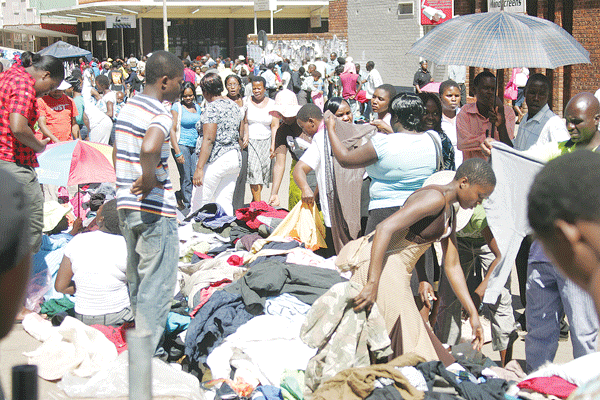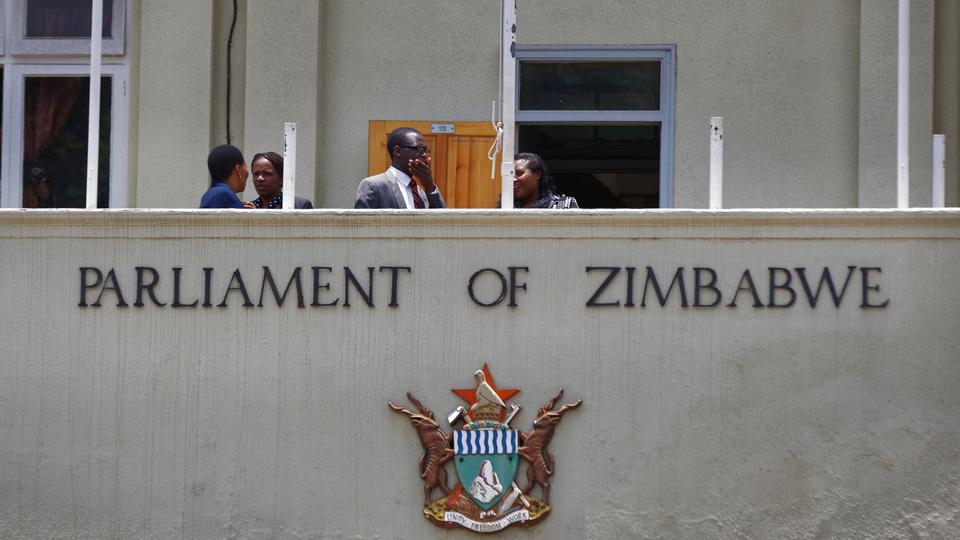
Loud cries fill the dusty air of the busy Copa Cabanna second hand clothes market in the capital of Zimbabwe, Harare. REPORT BY CECILIA KAMUPUTA The loud din from the men and women trying to entice customers blends in with the shouts from the ‘touts’ loading commuters into their omnibuses a stone throw away from the market.
“Dzakambopfekwa naJay-Z! Dzakambopfekwa naBeyonce! Dzakambopfekwa naRihanna!,” shouts another male crier wearing a dress with clothes stuffed in the front and behind to imitate a woman’s huge behind and breast, dancing around in the sweltering heat that is made worse by the black plastic covering the market from weather elements.
In the common lingo in Harare, Zimbabwe, the term Mupedzanhamo referred to a market that sold second-hand clothing imported from the West. Loosely translated, from Shona, it means that which finishes your woes or problems and the description is apt with the pricing of the clothing items.
The clothes are also referred to as Zitye, the Shona word for Sardines and might stem from the way these clothes are brought in, tightly packed in bales as Sardines are usually packed.
The global trade of second-hand clothing has a long history in Africa. During Europe’s colonial times, second-hand clothes were exported to the colonies and locally, charity shops mushroomed to accommodate the poor.
In Zimbabwe, it has grown rapidly in recent years as a result of the crumbling economy. Though most people see this phenomenon as normal, there is a lot more to these piles of used clothes displayed conspicuously all over the country than meets the eye.
Angeline Muderede, 41, from Marondera is in the second hand clothing business and specializes in children’s clothes. She hoards her wares from warehouses in Mbare for $150 to $250 a bale containing an average of 400 units. She then sells the clothes for $1.00 to $2.00 a unit and on a good day can get $40.00.
“However, with these incessant rains, business is really slow,” she said.
- Chamisa under fire over US$120K donation
- Mavhunga puts DeMbare into Chibuku quarterfinals
- Pension funds bet on Cabora Bassa oilfields
- Councils defy govt fire tender directive
Keep Reading
She added that since they sell in the open space at Gombo Supermarket , they are forced to pack up when it is raining thereby ruining their business.
“The second-hand clothing business has been helpful as it has allowed me to take care of my children in this environment of high unemployment rates and tough economy.”
At Mupedzanhamo Market in Mbare, a used pair of an adult’s jeans will typically cost from as little as $1 to $5 and a t-shirt from as little as $0.50.
Second-hand clothing is cheaper than the new alternative and normally of better quality.
A survey on social media platform Twitter on if people were open to wearing ‘pre-loved’ clothes and if not why had most recipients stating that they were, for various reasons.
“I just love the look and feel of most vintage dresses. And also when looking for brands, there is a higher chance of finding authentic stuff when you buy preloved clothes than when shopping in stores, especially here in Zim,” responded one user.
“Yup. I do, my favourite demin jackets were pre loved. I bought them each for a cool R50,” wrote another.
The second-hand clothing industry is big business but concerns over the health,economic and ethical repercussions have been raised.
It is second-hand underwear, which costs from as little as $0.30, that raises issues of hygiene, health and dignity and Zimbabwe once moved to ban the import of second hand intimate wear citing these issues in 2012 though these wares are still found on the market.
There is a small risk of infection or infestation from wearing second-hand clothing and bedding, according to the South Australian Health department.
“Bacteria organisms such as streptococci and staphylococci are very unlikely to survive on clothing or bedding in sufficient numbers and long enough to cause a health risk to the purchaser,” reads the SAH statement.
The statement adds that parasites however may survive for extended periods of time and while transmission of these organisms is unlikely, some second hand goods may result in a risk to health if they are not thoroughly cleaned before use.
Culturally and socially, there is a belief that used clothing bears the memory of its former wearer thereby making them an unpopular alternative to some.
French sculptor, photographer, painter and film maker, Christian Boltanski , in his installations titled ‘No Man’s Land’ in which used clothes were piled up, stated that every article of clothing symbolised a person.
“I see a garment as being equivalent to a body, It is like a photograph of someone, their heartbeat,” he added in an his 2010 interview with Sarah Rosenbaum-Kranson.
Along with cultural, health and social implications, there are also economic effects of second-hand clothing imports , mainly a dependency of Africa on the West , a hindrance to Africa’s development.
Fragile African economies had to relax barriers to imports of items like second-hand clothing which had at one time protected local companies with this, the industries further collapsed, workers lost their source of income thereby could only afford to buy second-hand clothing.
The selling and buying of the pre-owned clothes is aiding the rising of an imitation of the West and provides yet another case study of the unequal North-South, West-East relationships.
The largest exporters of second-hand clothing are the United States of America, the United Kingdom, Germany and the Netherlands whilst the largest importers are Sub-Saharan countries, receiving over 25% of the exports.
Banning of second-hand clothes, which a number of African countries are proposing, will not immediately solve any problems as most people in these economies are still not able to afford new alternatives to clothing and the alternatives are also limited, with clothes and textile companies shut down or operating below capacity.
In Zimbabwe, the period between 2000 to 2010 was hard for the clothing and textile sector . According to the Modor Intelligence article on Clothing and Textiles Industries in Zimbabwe: Analysis of Consumption and Production Trends Of Several Key Industries (2004-2014), the sector saw a number of companies closing and people employed in this sector losing their jobs.











